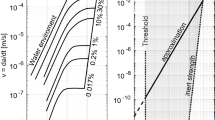Abstract
Fracture surfaces formed near the crack growth threshold in soda-lime-silicate glass are examined by atomic force microscopy. Cracks held below the apparent crack growth threshold for 16 h alter their mode of growth. The fracture plane changes from a flat surface to one that exhibits substantial out of plane growth. The direction of crack growth changes from 3° to 5° to the original growth direction. However, the change in growth direction is not uniform along the crack front; some portions of the front propagate at +3° to +5°, while adjacent portions propagating at −3° to −5° to the original growth direction. Thus, the crack is no longer flat, but becomes wavy after the 16 h hold period. This out of plane growth may be partially explained in terms of a crack growth model developed by Chuang and Fuller, which predicts an enhancement in the corrosion rate on the flank of a crack at stresses below the stress corrosion threshold. Alternatively, the unevenness of the crack plane after the hold period may be a consequence of a modification of the fracture toughness of the glass as a consequence of leaching.
Similar content being viewed by others
References
Charles, R.J. and Hollig, W.B. (1962). in Symposium on Mechanical Strength of Glass and Ways of Improving It, pp. 25-29. Union Scientifique Continentale du Verre, Charleroi, Belgium.
Chuan, T.-J. and Fuller, E.R., Jr. (1992). J. Am. Ceram. Soc. 75, 540.
Gehrke, E. and Ullner, Ch. (1988). Application of Fractography of Glass to the Study of Environmental Effects on Crack Growth. pp. 77-87 in Advances in Ceramics, V. 22, Fractography of Glasses and Ceramics, Edited by V.D. Fréchette and J.R. Varner), The Americal Ceramic Society, Inc. Westerville OH.
Gehrke, E. Ullner, Ch., and Hähnert, M. (1991). J. Mater. Sci. 26, 5445.
Guin, J.-P. and Wiederhorn, S.M. (2003). J. Non-Crystalline Solids 316, 12.
Hénaux, S. and Cruezet, F. (1997). J. Am. Sci. Let. 16, 1008.
Kocer, J. and Collins R.E. (2001). J. Am. Ceram. Soc. 84, 2585.
Michalske, T.A. (1977) in Fracture Mechanics of Ceramics, Vol. 5, Surface Flaws, Statistics, and Microcracking, pp. 277-289, (Edited by Bradt, R.C., Evans, A.G., Hasselman, D.P.H. and Lange, F.F.) Plenum Press, New York.
Wiederhorn, S.M. and Bolz, L.H. (1970). J. Am. Ceram. Soc. 53, 543.
Author information
Authors and Affiliations
Rights and permissions
About this article
Cite this article
Wiederhorn, S., Dretzke, A. & Rödel, J. Near the static fatigue limit in glass. International Journal of Fracture 121, 1–7 (2003). https://doi.org/10.1023/A:1026274817003
Issue Date:
DOI: https://doi.org/10.1023/A:1026274817003




